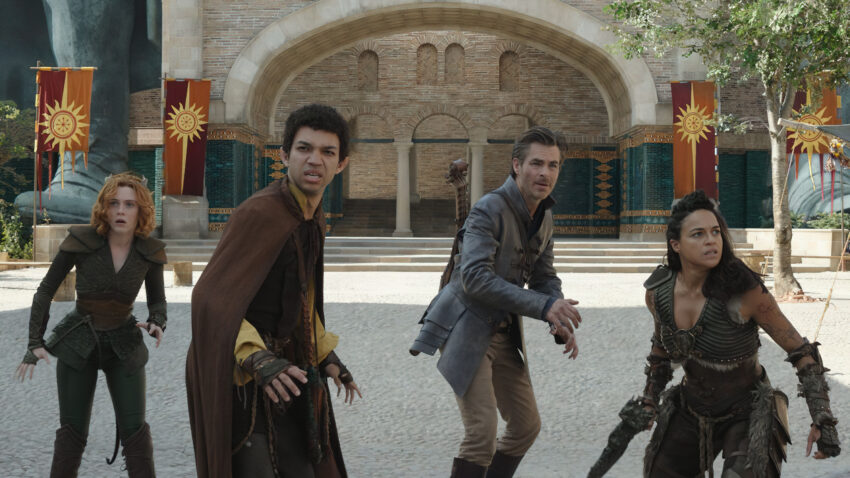There is so much good that could be said about Honor Among Thieves. It might be the best movie that came out of 2023. I’ve known I want to write a blog post about it for months, but most of what makes the story so good is just its strength in the foundational aspects storytelling — characters with goals, desires, and fears; villains with understandable motivations who we aren’t supposed to sympathize with; epic battles between good and evil; characters who deal with crushing internal conflict; and families that will stop at nothing to be together again.
But there’s one thing in particular that this movie did that most don’t. Namely, they let their characters fail. More specifically, they allowed every plan they came up with to fall through, until the impossible task they set out to accomplish began to seem as unlikely as it really was.
So today, to dive into this unusual and under-used technique, we’re going to be looking at how the characters in Honor Among Thieves failed, and how their failures improved the story.
Honor Among Thieves
Egdin is a widower and bard-turned-thief in a band of outcasts who’ve sworn only to steal what they need and only from those who would feel it the least. Together with his young daughter, Kira, and a fighter named Holga, the three of them formed a found family after his wife’s death and joined a band of thieves to make ends meet. But everything changed when they were approached by a mysterious wizard willing to help them break into a top-secret vault to plunder the magical items inside — including an ancient Tablet of Reawakening powerful enough to resurrect Edgin’s wife. But the mission goes poorly, landing both Edgin and Holga in the depths of a high-security prison. Edgin’s only hope is to get out, get back to his daughter, and find some semblance of the life they led before they were captured.
But when they finally do escape, they find their friends are gone and that one of them, the expert conman Forge Fitzwilliam, has betrayed them. He’s kidnapped Edgin’s daughter and allied himself with one of the most powerful — and most evil — beings in the world: a Red Wizard of Thay. Now he’s using the magical items he stole from Edgin while he was imprisoned to leverage a grand bid for power, intending to become a dictator of their country and raise Kira as his own.
So Holga and Edgin set out to find allies. But the only people both desperate enough to face a Red Wizard and good enough to help Edgin rescue his daughter are an amaetur magician named Simon and the shapeshifter-revolutionary Doric. Together, the four of them attempt to break into a well-protected castle, steal the treasure from Forge’s vault, find and rescue Kira, and finally use the Tablet of Reawakening to save Edgin’s wife.
Letting Your Characters Fail
Unfortunately, nothing goes as planned.
Over the course of the movie, they are forced to come up with a grand total of four (4) plans, each of which ends poorly and leaves them facing a dozen dead ends and a seemingly hopeless situation. Unlike a lot of adventure stories, where the characters are faced with a singular task, must see the plan through to the end, and generally make it through even if the quest didn’t go exactly as planned, Honor Among Thieves threw out the conventional structure over and over again, creating a much more realistic plot.
But realism isn’t the only benefit that comes from throwing off all your characters’ plans at once. This week, we’re going to look at three others that come with this technique, and how you can incorporate them into your own work.
1. Avoid Predictability
Most of us know how the story is going to end. The heroes win, the villain is defeated, everyone goes home. Even if your ending isn’t perfect, the readers can usually infer a decent amount of the plot by the genre, tone, and direction of the story. While tension and suspense can be generated even when so much about the plot can already be inferred, using this technique can create an extra level of unpredictability around the plot. Throwing off your character’s plans can keep your readers on their toes. As viewers, we will never be able to see exactly how the characters were going to succeed.
This was definitely the case in Honor Among Thieves. We could tell it wouldn’t end in tragedy and that the villains would ultimately be defeated one way or another just from the tone of the movie. So one way the writers generated interest around the plot’s development was the way that the characters’ plans constantly had to be changed, adapted, or abandoned altogether. One moment, it was all up to Simon’s magic abilities; the next they had to face a deadly, gladiator-style tournament to survive. But just as quickly, the characters had thought their way out of the tournament and were then thrust into a battle with the impossibly powerful Red Wizard — once again switching up the direction (and predictability) of the work.
2. Lets Your Characters Wrestle With Defeat
Like we talked about last month, fully rounded characters experience a full range of emotions. That doesn’t just mean they’re awkward or funny, but also that they can wrestle with despair and triumph. While this kind of emotion is less likely to be missed than having a character feel awkward, it is no less important. When you let your characters fail, you’re showing your readers how they react to difficulty. Does it cause fighting among the group? Does it allow one of your characters to open up with the others?
In the case of Honor Among Thieves, it did both. It nearly tore apart the party, with several characters planning to leave until Egdin finally admits the truth about his past and why this mission matters so much to him. The personal aspect of the mission gave them all the ability to see past their differences and determine to challenge the villains in one final stand — once again abandoning their old plan for a brand-new one that targets the antagonists on a completely different (and unexpected) front.
And it has happened in other fantasies, as well. We never would have gotten to see the strength of Samwise Gamgee’s character if the Fellowship of the Ring hadn’t been dissolved and he hadn’t had to literally carry what was left of it across his shoulders to Mordor. We wouldn’t have been able to watch Aragorn charge into battle, or see Merry face the Nazgul. Throwing off your characters’ plans is crucial to showing how they react in unexpected, uncomfortable, and unpredictable environments.
3. Avoid Plot Armor
With stakes as high as readers expect these days and the odds of succeeding so low, a happy ending can often feel forced, especially if the obstacles along the way didn’t do much but slow the protagonist down. But when you throw a wrench into your characters’ plans and completely wreck their expectations, you can show your readers that your characters aren’t invincible. They become far more vulnerable to attacks, surprises, and tragedies because they already have no idea what to expect.
This shows your readers that your characters aren’t invincible. Their plans aren’t perfect and they can’t anticipate every obstacle. They aren’t guaranteed to succeed, even if their plan seems flawless at first. You can manipulate the plot and setting to do somewhat of a reverse Deus Ex Machina by intentionally making their plans far more difficult or even impossible than they anticipated. And it’s that angle of unpredictability that will make your characters and world seem so much more tangible and realistic.
4. Show their character
Like we looked at with Agent Carter, you can show your characters’ strength and resilience by having them deal with something difficult — and having to abandon a plan on which they placed all their hopes and aspirations definitely fits the bill. When your characters’ hopes are dashed and their plans and effort seem to have come to nothing, you have a clear opportunity to show off their resilience — or that they don’t have any, if they don’t.
Edgin is determined to rescue his daughter. Even when all his friends abandon him and he’s hit rock bottom without allies, a plan, or resources, he decides to adapt and try to think his way around the obstacles in front of him. Their family has already been harmed past repair, so he will stop at nothing to hold together what’s left of it, even if he’s woefully inadequate and there seems to be no way for him to do it on his own. His undying resilience, untiring effort, and optimistic attitude shows the audience just how much he cares about his daughter and the fact that he will do anything to rescue her, even if it means risking his own life over and over again. These continued acts of love and determination make their bond that much stronger and more genuine, and they show just how much Kira matters to Edgin.
Not all stories have to completely throw off their characters’ plans. Sometimes a story can be told just as artfully because the characters know exactly what dangers and difficulties they’re going to have to face, and yet they do the right thing anyway. But there are serious benefits to having your characters start out with a plan that you (as the writer) have doomed to fail from the start. Whether or not you choose to use this technique for your own work, make sure you show your characters’ weaknesses, how they wrestle with defeat, and most of all the resilience that brings them through it.



What characters have you watched fail? What did it show you about their character? Do you plan on letting your characters fail in your current WIP? Let us know in the comments below!


Hi! My name is Mara, and I’m a Christian artist, violinist, and blogger. I remember the day that I decided that I would learn something new about what makes a good story from every book I picked up — whether it was good, bad, or a mixture of both. I use this blog as a way of sharing some of the tips and tricks I’ve learned, and highlight which books, cartoons, and movies have taught me the most about writing an awesome story.


Very cool!
Part of me thinks that I should have someone fail, buuuuuut they are all traumatized enough. And it’s hard to fail if you’re goal is just…. staying alive long enough for someone to find you. 😓
My honest first reaction was “Hey wait…. that guy was in Detective Pikachu!”
“Simon” was played by Justice Smith, who played “Tim Goodman”. (His acting was ‘meh’ in my opinion, I hope he was better in this one.)